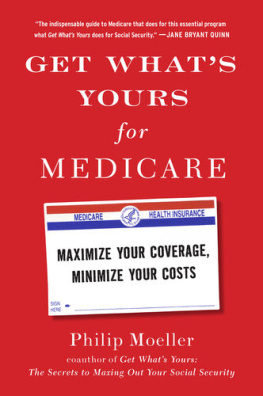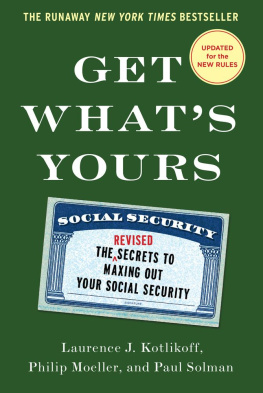Philip Moeller - How to Get the Best Care at the Right Price
Here you can read online Philip Moeller - How to Get the Best Care at the Right Price full text of the book (entire story) in english for free. Download pdf and epub, get meaning, cover and reviews about this ebook. year: 2021, publisher: Simon & Schuster, genre: Home and family. Description of the work, (preface) as well as reviews are available. Best literature library LitArk.com created for fans of good reading and offers a wide selection of genres:
Romance novel
Science fiction
Adventure
Detective
Science
History
Home and family
Prose
Art
Politics
Computer
Non-fiction
Religion
Business
Children
Humor
Choose a favorite category and find really read worthwhile books. Enjoy immersion in the world of imagination, feel the emotions of the characters or learn something new for yourself, make an fascinating discovery.
- Book:How to Get the Best Care at the Right Price
- Author:
- Publisher:Simon & Schuster
- Genre:
- Year:2021
- Rating:4 / 5
- Favourites:Add to favourites
- Your mark:
- 80
- 1
- 2
- 3
- 4
- 5
How to Get the Best Care at the Right Price: summary, description and annotation
We offer to read an annotation, description, summary or preface (depends on what the author of the book "How to Get the Best Care at the Right Price" wrote himself). If you haven't found the necessary information about the book — write in the comments, we will try to find it.
How to Get the Best Care at the Right Price — read online for free the complete book (whole text) full work
Below is the text of the book, divided by pages. System saving the place of the last page read, allows you to conveniently read the book "How to Get the Best Care at the Right Price" online for free, without having to search again every time where you left off. Put a bookmark, and you can go to the page where you finished reading at any time.
Font size:
Interval:
Bookmark:


ALSO BY PHILIP MOELLER
Get Whats Yours for Medicare: Maximize Your Coverage, Minimize Your Costs
Get Whats Yours: The Secrets to Maxing Out Your Social Security (with Laurence J. Kotlikoff and Paul Solman)
How to Live to 100: Be Healthy, Be Happy, and Afford It (with Lindsay Lyon and Kimberly Palmer)

Simon & Schuster
1230 Avenue of the Americas
New York, NY 10020
www.SimonandSchuster.com
Copyright 2021 by Philip Moeller
All rights reserved, including the right to reproduce this book or portions thereof in any form whatsoever. For information, address Simon & Schuster Subsidiary Rights Department, 1230 Avenue of the Americas, New York, NY 10020.
First Simon & Schuster hardcover edition January 2021
SIMON & SCHUSTER and colophon are registered trademarks of Simon & Schuster, Inc.
For information about special discounts for bulk purchases, please contact Simon & Schuster Special Sales at 1-866-506-1949 or .
The Simon & Schuster Speakers Bureau can bring authors to your live event. For more information or to book an event, contact the Simon & Schuster Speakers Bureau at 1-866-248-3049 or visit our website at www.simonspeakers.com.
Cover design by Math Monahan
Library of Congress Cataloging-in-Publication Data
ISBN 978-1-9821-3425-9
ISBN 978-1-9821-3428-0 (ebook)
To Cheryl, Kay, Daniel, and Jonmy heroes in all things
 HEALTH INSURANCE BASICS
HEALTH INSURANCE BASICSIn 2019, Donna Ferguson was a poster child for Americas out-of-control health care prices and the game-changing ways now emerging to find better and cheaper care. Her meme status stemmed from a story that explained how Fergusons employerprivately held Ashley Furniture Industries in Wisconsinhad paid for her to fly to Cancun from her home in Mississippi and then put her up in a nearby Sheraton hotel. It flew in a surgeon trained at the Mayo Clinic, and paid him to give her a knee replacement that was free to her.
The quality of the surgery and her care were first-rate. The costs for the procedure at a nice hospital were so much cheaper than in the United States that Ashley, which self-insures its health care coverage, came out aheadso far ahead that the company cut her a $5,000 check to reward her for her troubles!
In 2020, by sobering contrast, the COVID-19 pandemic took us back decades. There were shortages of critical-care equipment, hospital beds, and caregivers, plus tragic weaknesses in nursing homes. But we also saw what we had been missing in health care.
Dedicated and compassionate healers put their lives on the line. Hospitals, doctors offices, pharmaceutical and insurance companies, and health care regulators relaxed or waived access and pricing rules so people could get protection and care. Health care heroes were everywhere. This was a health care system we could support.
Beyond the compassionate heroics, what was wrong with U.S. health care in 2019 is not only still wrong today but likely even worse. We have too few caregivers, rising affordability challenges, and a profit-driven system at odds with human needs. However, the pandemic also accelerated positive forces surrounding Fergusons treatment. They can make health care work for us, not the other way around.
Get Whats Yours for Health Care will explain what you can do right now to benefit from these changes. They are elements of a consumer-focused shift in care that is happening now and not waiting for government health reforms.
Self-insured employers like Ashley Furniture are beyond tired of paying out the nose for rising health costs. The tab for employer health insurance is about $700 billion a year and rising at double the rate of general inflation. This does not include the $375 billion in annual premiums and other out-of-pocket health care costs that we as employees pay.
Singly and in growing groups of like-minded organizations, employers are bypassing traditional health pathways. They are contracting directly with hospitals, doctors, and other providers of high-quality care at advantageous prices. These early adapters are proving how to save moneyfor themselves and their employeeswhile providing new incentives and decision-making tools that support healthier work forces.
Employer efforts to break the cycle of unsustainable health cost increases are hardly new, of course, so whats changed? The short answer is digitized information and big data. It has taken hold of health care, just as it has other aspects of our lives.
The ability to capture and analyze massive amounts of health care information has guided existing companies and thousands of venture-backed start-ups to find ways to cut health waste and costs while improving the quality of care.
Within the medical community, this information has created pathways to evidence-based care. What works and what doesnt? Where are doctors, hospitals, and other medical experts likely to make mistakes in their diagnoses and treatment recommendations? What does health care quality look like, which providers do it the best, and how can you find them?
The organizations and people who pay for health carethat means us!are learning what care costs and not just what providers charge. Health insurers gather this information as part of their work to process and pay claims. They keep it to themselves, for privacy reasons and because the knowledge generated by their claims information is a competitive asset.
With self-insured plans, the insurers dont always call the shots. They work for employers under administrative service contracts. These employers thus have the opportunity to know the prices their health plans have agreed to pay doctors, hospitals, and other health care providers. Thanks to the enormously detailed coding systems for medical billing that are now standardized, they can get detailed apples-to-apples comparisons of health payments where their employees receive care.
Even without government involvement, health care is already being reformed. Compelling signs that major changes are near a tipping point were provided last spring when hospitals were flooded with COVID-19 victims and closed to routine care, as were doctors offices.
Virtual health care, also known as telemedicine or telehealth, boomed. A study from management consultants at McKinsey & Company estimated that telehealth services soared in March 2020 from 0.2 percent to 7.5 percent of private health insurance claims. Total spending on telehealth, it projected, could rise to $250 billion a year, or nearly 100 times what had been forecast before the pandemic closed down much of the country.
Health providers have rapidly scaled offerings and are seeing 50 to 175 times the number of patients via telehealth than they did before, the report said. Ten years of projected growth occurred in sixty days.
Healthcare Bluebook, based in Nashville, Tennessee, was formed in 2008 because cofounders Jeff Rice and Bill Kampine believed they could unlock the secrets of health care pricing, find employers and others willing to pay them for their efforts, and, in the process, create tools to help employees and consumers understand the true cost of health care and how to find care that was less expensive and higher in quality.
Font size:
Interval:
Bookmark:
Similar books «How to Get the Best Care at the Right Price»
Look at similar books to How to Get the Best Care at the Right Price. We have selected literature similar in name and meaning in the hope of providing readers with more options to find new, interesting, not yet read works.
Discussion, reviews of the book How to Get the Best Care at the Right Price and just readers' own opinions. Leave your comments, write what you think about the work, its meaning or the main characters. Specify what exactly you liked and what you didn't like, and why you think so.






![Moeller - Creative slow-cooker meals: [use two slow cookers for tasty & easy dinners]](/uploads/posts/book/220959/thumbs/moeller-creative-slow-cooker-meals-use-two-slow.jpg)






